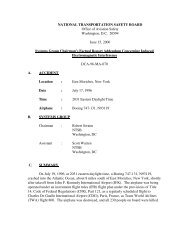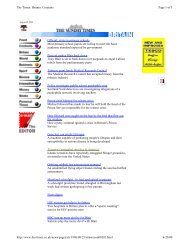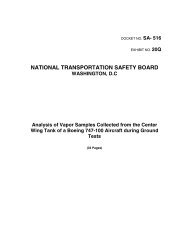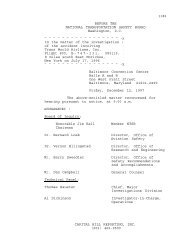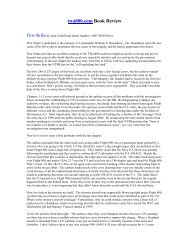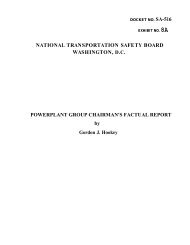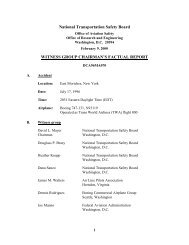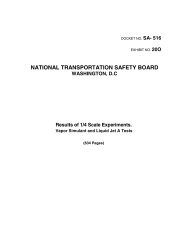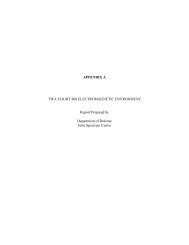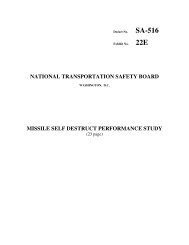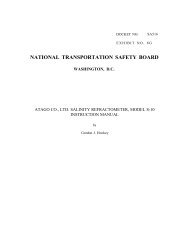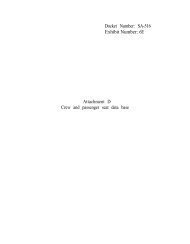Exhibit No. 11A - Group Chairman Factual Report - TWA Flight 800 ...
Exhibit No. 11A - Group Chairman Factual Report - TWA Flight 800 ...
Exhibit No. 11A - Group Chairman Factual Report - TWA Flight 800 ...
You also want an ePaper? Increase the reach of your titles
YUMPU automatically turns print PDFs into web optimized ePapers that Google loves.
25FUEL QUANTITY TANK UNITSThere are a total of 65 fuel quantity tank units probes, and 13 fuel quantity compensators locatedthroughout the 747-131 aircraft. The locations of the fuel quantity tank units are: four in the <strong>No</strong>. 1 and<strong>No</strong>. 4 reserve tanks; 13 in the <strong>No</strong>. 1 and <strong>No</strong>. 4 main fuel tanks; 12 in the <strong>No</strong>. 2 and <strong>No</strong>. 3 main fuel tanks;and seven are located in the center wing fuel tank.The fuel quantity compensators are located two in the <strong>No</strong>. 1 reserve tank; one in the <strong>No</strong>. 4 reservetank; one in each surge tank; two in the <strong>No</strong>. 1 and <strong>No</strong>. 4 main fuel tanks; two in the <strong>No</strong>. 2 main fuel tank;one in the <strong>No</strong>. 3 main fuel tank; and one in the center wing fuel tank.The fuel quantity tank units and compensators are “condition monitored” items and are removed fromthe airplane when the unit is inoperative. When an inoperative unit is identified, the unit is removed fromthe airplane and replaced with an airworthy unit. The inoperative unit is then sent to the <strong>TWA</strong>maintenance base in Kansas City for inspection.The fuel quantity tank units were manufactured by Honeywell. <strong>TWA</strong> inspects/repairs/overhauls theunits in accordance with the Honeywell overhaul manuals and <strong>TWA</strong>’s reliability control programspecifications established or approved by <strong>TWA</strong> engineering.<strong>TWA</strong> overhaul shop records indicate that all fuel quantity tank units and compensators installed inN93 119 are the original units that were installed during manufacture in 1971.Unless there is a malfunction of the fuel quantity tank units or compensators that requires unscheduledmaintenance, the units are inspected during the scheduled “D” Check.POWERPLANT REVIEWThe aircraft maintenance log was reviewed from July 1-17, 1996, and identified engine discrepanciesand the work accomplished. The following text identifies the engine write-ups.Engine position number 1, serial number 662209, was remwed from N93119 on June 26, 1995, for hotsection distress. The repair was performed at Kansas City (MCI) on <strong>No</strong>vember 16, 1995, and the enginewas re-installed, at New York (JFK), in position number 1 on December 31, 1995.Maintenance write-ups and work performed on the engine since July 1, 1996, were:● July 1, 1996- The Exhaust Gas Temperature (EGT) exceeded the limits to 920 degrees C for 90seconds. An inlet and exhaust inspection waa performed, along with a duct leak check. All wasreported as normal.● July 1, 1996- The EGT exceeded the limits to 920 degrees C for 30 seconds. This temperaturewas located in area “A” on the over-temperature chart. The over-temperature was caused by amaximum power takeoff. The maintenance records indicate that the number one EGT indicatorwas replaced. The inlet and exhaust were checked, inspected and found “okay.”● July 13, 1996- The number one Engine Pressure Ratio (EPR) indicator was sticking. Themaintenance records indicate that the engine EPR indicator was replaced and then checked.●July 14, 1996- The number 1 engine EGT exceeded 970 degrees C for five seconds. Thetemperature was located in area “C” on the over-temperature chart. The over-temperature wascaused by unexpected rapid spool-upon the engine for takeoff. The maintenance records indicatethat an inlet and exhaust duct leak check was accomplished. The hot section and turbine sectionwere borescoped and checked as “okay.”





